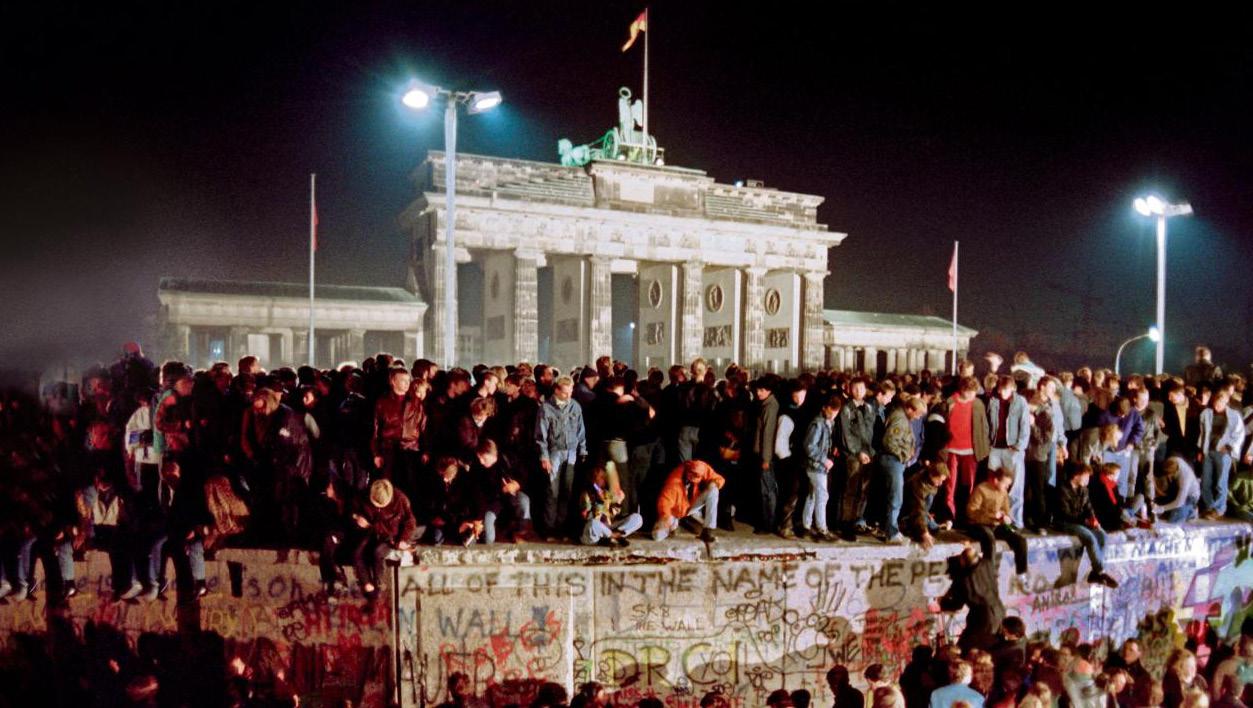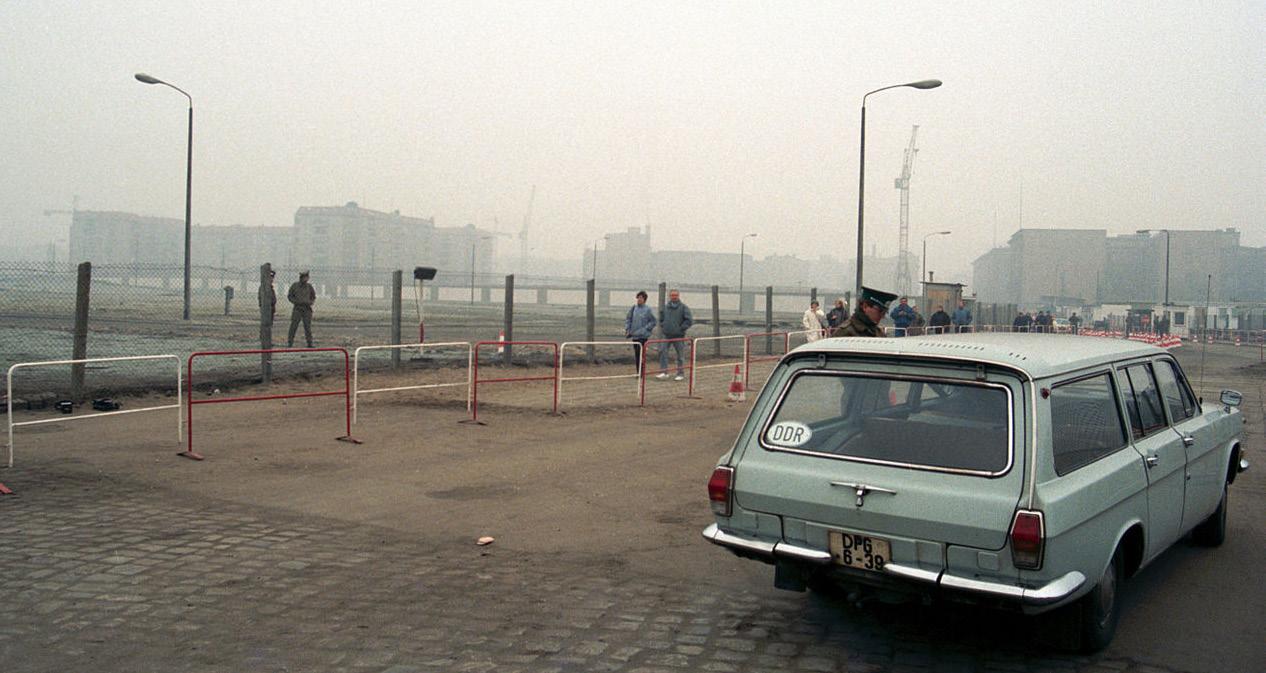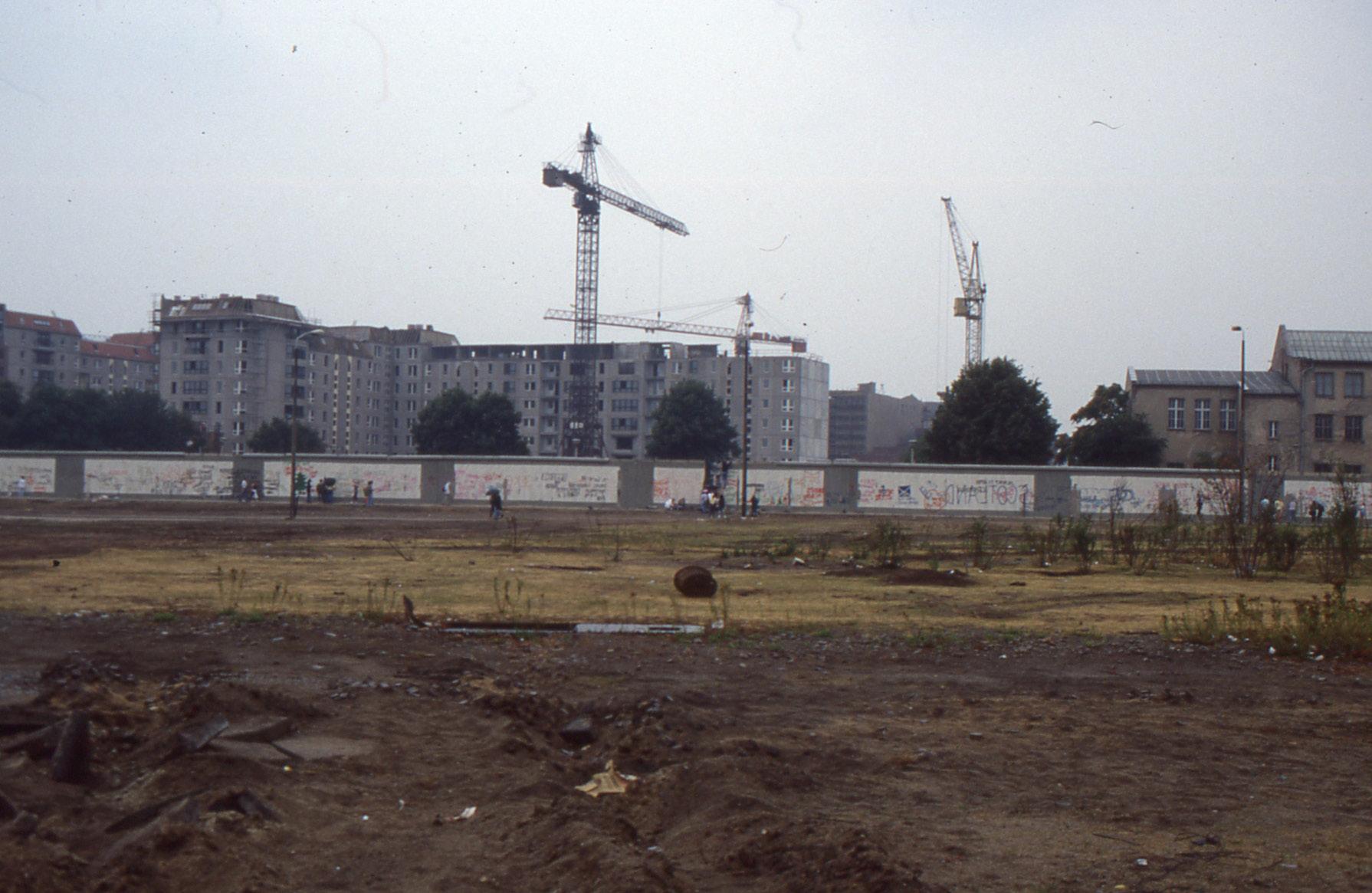
11 minute read
introduction
die wende.
fig. 0.1
Advertisement
Mauerfall 9. November 1989
Late on the evening of the 9th November 1989, East German border guards at the Bornholmer Strasse checkpointrelinquished to the demands of an ever growing, jubilant crowd, and removed all barriers to the West [1] . Within hours, all of Berlin’s crossings had followed suit and thousands of citizens ventured across the border, many for the first time in their lives. Der Mauerfall or fall of the Berlin Wall marked a moment of collective euphoria for Berliners across both sides of the divide as the perceived permanence of the Cold War stalemate came crashing down. This moment can be seen as the culmination of the peaceful revolution or die Wende that had gained traction across East Germany and other member states of the Communist Bloc throughout 1989. Literally translating as the turning point, the Wende had seen citizens in the East defy their repressive authorities by gathering in urban areas to demand freedom of movement to the West, genuine democracy and greater human rights. [2] Since 1945, Germany had been split along the lines of the victors of WWII. The territory under control of the western allies formed the Bundesrepublik Deutschland, while the east of the country developed into the Deutsche Demokratische Republik or DDR. The former embraced liberal western capitalist values while the latter, laying under the sway of the Soviet Union (USSR), carried authoritarian state structures and a centrally planned economy. [3] The city of Berlin came to be defined by the stand off between the two Germanies and the ideologies they represented. As the
[1]__Berlin.de. (2016). Opening and fall of the Berlin Wall - Berlin.de. [online] Available at: https://www.berlin. de/mauer/en/history/opening-of-the-wall/.
West Berlin East Berlin
- Berlin Wall Line
ever greater political tension between the USA and USSR played out on the streets of Berlin, in 1961 the East responded by commencing construction of the so called ‘Anti-Fascist Protection Wall’ as a means to physically split the city and prevent the mass exodus of its citizens to the West. [4] Over the years this Wall would come to be the most fortified border in world and claim countless lives for those who attempted escapes in the pursuit of freedom. Moreover the ensuing decades of Cold War confrontation sowed division into the streetscapes of a city that had, in its golden age been one of Europe’s most thriving and cosmopolitan capitals. As I will set forth in this dissertation, the resulting urban topography formed by the extremes of twentieth century politics would leave indelible impressions onto both the city’s psyche and built environment for generations to come.
After twenty-eight years divided, East and West Berliners overnight found themselves thrown together once more. By 1990, the two Germanies had become one as the DDR state dissolved and its leadership accepted reunification with the West. This moment beckoned a period of national introspection as Europe’s now largest nation sought to redefine a collective identity. As I will argue, urban space was perceived to perform an intrinsic role in the construction of the new nation and healing of the wounds of its volatile histories. With the ghosts of national socialism and the DDR dictatorship still haunting the city, Berlin was seen as inherently tied to German reconciliation with the past and aspirations for the future. [5] As a consequence in 1991, after months of nation-wide debate it was decided that the federal parliament should be returned to the city (after having been situated in the town of Bonn
[4]__Schick, J.M. (1971). The Berlin crisis, 1958-1962. Philadelphia, University Of Pennsylvania Press.
fig. 0.2
Division Partition Lines
since 1949). This retrieved status as a capital city set the course for Berlin’s dramatic transformation over the following years and cemented its ambitions to become a globally competitive, European metropolis. Having been governed for the past forty years by two disparate political systems, planners found themselves negotiating immense challenges of forming a new urban image fit for the reunified nation; whilst bringing together two separate autonomous cities and identities. The extremes of public sentiment and intense debate over the built environment reveal the contentions that existed in German society during this period.
[VOIDS]
The felling of the Wall exposed the virtual and physical voids in Berlin’s streetscapes that had emerged from its construction. At its largest, the border between East and West had comprised of two monolithic walls sandwiching a vast stretch of no-man’s known as the ‘death strip’. [6] With the installation gone, the city was left with large swathes of wilderness in its centre, known by locals as the ‘prairies of history’ [fig.0.3/4]. [7] These haunted voids spoke by means of absence, of the traumas experienced by Berliners in the twentieth century and naturally became the focus of redevelopment as planners attempted to normalise the physical landscape for the approaching new millennium. 'Normalisation’ was a dominant theme surrounding much of the debate concerning the reconstruction of the reunified capital. As Brian Ladd notes in the seminal work, Ghosts of Berlin, politicians and critics were spilt between those fervently yearning for the urban normality present in neighbouring Western democracies and those who believed that spaces such as the voids of Berlin should be maintained as reminder to the burdens of Germany’s history. [8]
Beyond the physical gaps in the city, remained the lingering psychological legacy of the divide. Accordingly attitudes to the Wall differed greatly on either side. For those in the East it represented the physical embodiment of a system of repression and as such fed into a collective trauma. A form of depression named Mauerkrankheit or wall sickness, unique to Eastern citizens living alongside the border infrastructure, reveals the scarring impact the Wall had on the DDR’s imprisoned population. [9] Conversely those on the West, held the Wall with a different regard since it did not pose a direct threat to their lives or personal freedoms. Arguably the legacy of these differing perspectives aggravated the already deep rifts along East-West lines that had formed from the two states’ political and economic divergence. In many ways the redevelopment of Post-Wende Berlin was marked by these differences. Contestation between the former 'Wessis' - West Berliners and the 'Ossis' - East Berliners, now centred on the outcome of the built environment
[6]__Burkhardt, H. (2001). Facts of Berlin Wall - History of Berlin Wall. [online] www.dailysoft.com. Available at: http://www.dailysoft.com/berlinwall/history/facts.htm.

and the grappling over the physical and cultural legacy of the DDR. [10] Anxieties built up over decades goes far to explain decisions taken in the reunified capital with both sides fearing the domination of the other over the ‘new Berlin’. Being the clear victor of the Cold War, the West held the upper hand in the sway for control of the streets. The often aggressive means in which the voids of Berlin were filled is telling of the decisions made by large-scale public and private investment partnerships in their bid to effectively control the image of the reunified city.
[STRUCTURE]
The 1990s witnessed a period of truly monumental building activity in the pursuit of the ‘new Berlin’. During this time the skyline was dominated by cranes and construction sites as major projects broke ground throughout the capital. ‘Critical Reconstruction’, a planning strategy devised by the largely Western-dominated city governance sought to normalise the built fabric by reinstating street plans and architectural styles from the pre-war city. Numerous large scale projects were built according to the tenets of ‘Critical Reconstruction’ including: the redevelopment of Potsdamer Platz, the new government quarter for the reinstated German parliament and the complete renewal of the old town centre of Freidrichstadt. Chapter one discusses these projects in relation to the frenzy to curate the image of a burgeoning global city that was representative of a new German statehood. By analysing the production of image and cultural symbology through the architectural interventions of the 1990s I will suggest how these urban interventions can be read as seeking to wipe the city clean of the memory of the DDR.
fig. 0.3
Voids Potzdamer Platz in 1990
fig. 0.4
Commentators such as Claire Colomb, have argued that the co-ordination of critical reconstruction projects during this time constituted a ‘staging’ of the ‘new Berlin’ through the purposeful manipulation of the physical history of the city in pursuit of new identities:
"alongside the new, gleaming corporate headquarters and government centres, Europe’s largest building site [was] also the scene of the postand … rhetorically"
[11]
unification construction of German history and identity – ethically, politically,
The 'Prairies of History' Potzdamer Platz -1995

The notion of ‘staging’ is further explored in Chapter 1 through the analysis of the visual sensations of mass redevelopment of the city throughout the period of reunification. These years saw the use of public event and spectacle to act as a marketing tool to sell the vision of the future city to locals, investors and tourists alike. [12] Encompassed within these strategies was the extensive use of construction sites to act as the backdrop for a wide array of celebratory performances and tourist attractions that attempted to convey the image of the city of ‘tomorrow’. In this way the thesis looks to how the city streets of Berlin have been politicised through the medium of event, with the ‘festivalisation' of urban planning strategies exhibited during this time being used as a means for healing but simultaneously acting as a means to exerted claims to urban space. Chapter two expands on these themes to explore the struggles and debates that raged over the erasure of the physical legacy of the DDR through the wider actions of the city municipality. I argue that the principles of historical
[11]__Colomb, C. (2012). Staging the New Berlin : place marketing and the politics of urban reinvention post-1989. New York: Routledge.
manipulation undertaken through the medium of critical reconstruction, was continued through the assault on urban memories of the East’s streetscapes. By re-constructing the historic struggles over monuments and the widespread practice of renaming streets after the Mauerfall, the thesis points to the politicisation of collective memory, which for Berlin played out through its highly contentious urban landscape. The struggles for and against the identity of the East is representative of the diverse range of actors seeking to influence the formation of the new city’s image. In many ways although the actions of the city fathers and their public-private partnerships dominated much of the redevelopment of the city, shown by the backlash of former Ossis against the attacks to their culture is the degree of power still held by grassroots campaigns over urban identity. Chapter three discusses this notion in further detail through the exploration of the ways in which autonomous underground scenes claimed urban space by exercising new freedoms afforded by unification. The Post-Wende conditions of Berlin allowed counter culture movements to flourish in the landscape of vacant buildings left by the demise of the DDR. In this context, the actions of the squatting movement and techno scene are interrogated to understand how these groups strived to define alternative ways of being through use of the city and event whilst combating the neo-liberal advances of the capital-wide redevelopments.
Post-Wende Berlin’s rapid metamorphosis has drawn a plethora of academic interest over the years since the wall fell. It is within this context that the study seeks to develop a unique angle by examining the politicisation of urban space through the interplay of actions from both public-private intervention with those of autonomous, subcultural movements. The motivation to study this topic, is, in its widest sense led by a desire to understand the means in which architecture and the built environment play an intrinsic role in the performance of collective identity and statehood. The dramatic upheaval encountered during this time can be viewed in many ways as a globally unique

fig. 0.5
Construction Tourism Tourists flock to Potzdamer Platz in 1996
event that nonetheless holds value for the better understanding of urban processes. In particular the manner in which the streets of Berlin were used to stage new national identities provides a fascinating insight into the effects of regime change onto the city streets. Berlin through its past has shown itself to be a highly malleable site that throughout the twentieth century was made and re-made according to the desires of successive creators, in turn revealing the artificiality of urban space. The seismic shifts of the Wende, left a city grappling with the questions of how to deal with the physical reminders of uncomfortable pasts. The debates of this period bear a striking relevance to the problems faced by contemporary urban governments in battles between preservation and erasure that result from troubling histories. By studying the streets of the Post-Wende capital it is possible to view the deep structures of German society at this moment and the inventive use of urban space, spectacle and event as attempts to enable its healing. The scramble to define the new city in the wake of the events of 1989 laid bare the contestations of reunification, as government, private investment, counter-culture and hedonism from East and West fought to claim the streets in their name. As the years would reveal, everything was up for grabs.






